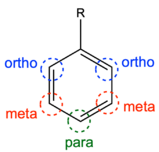Chemistry:Electron-withdrawing group
An electron-withdrawing group (EWG) is a group or atom that has the ability to draw electron density toward itself and away from other adjacent atoms.[1] This electron density transfer is often achieved by resonance or inductive effects. Electron-withdrawing groups have significant impacts on fundamental chemical processes such as acid-base reactions, redox potentials, and substitution reactions.[1]
Consequences of EWG's
Effects on Bronsted acidity
Electron-withdrawing groups exert an "inductive" or "electron-pulling" effect on covalent bonds. The strength of the electron-withdrawing group is inversely proportional to the pKa of the carboxylic acid.[2]
The inductive effect is cumulative: trichloroacetic acid is 1000x stronger than chloroacetic acid.
The impact of the EWG group on pKa decreases with distances from the carboxylic group.
For benzoic acids, the effect is quantified by the Hammett equation:
- [math]\displaystyle{ \log \frac{K}{K_0} = \sigma\rho }[/math]
where
- [math]\displaystyle{ {K}_0 }[/math] = Reference constant
- [math]\displaystyle{ \sigma }[/math] = Substituent constant
- [math]\displaystyle{ \rho }[/math] = Reaction rate constant
Effect on Lewis acidity
EWGs enhance the Lewis acidity, making compounds more reactive as Lewis acids. For example, fluorine is a stronger electron-withdrawing substituent than methyl, resulting in an increased Lewis acidity of boron trifluoride relative to trimethylborane. Electron-withdrawing groups also tend to reduce Lewis basicity.[3]
Effect on a aromatic substitution reactions
Electrophilic aromatic substitution is famously affected by EWGs. The effect is transmitted by inductive and resonance effects.[1] Benzene with an EWG typically undergoes electrophilic substitution at meta positions. Overall the rates are diminished. thus EWGs are called deactivating.
When it comes to nucleophilic substitution reactions, electron-withdrawing groups are more prone to nucleophilic substitution. For example, chlorodinitrobenzene is far more susceptible to reactions displacing chloride compared to chlorobenzene.[4]
Effects on redox potential
In the context of electron transfer, these groups enhance the oxidizing power tendency of the attached species. For example, Tetracyanoethylene serves as an oxidant due to its attachment to four cyano substituents, which are electron-withdrawing groups.[5]
Oxidants with EWGs are stronger than the parent compound. Acetylferrocenium is 300 mV more oxidizing than ferrocene.
Comparison with electron-donating groups
Electron-withdrawing groups are the opposite effect of electron-donating groups (EDGs). Both describe functional groups, however, electron-withdrawing groups pull electron density away from a molecule, whereas EWDs push electron density onto a substituent.[6]
See also
- Electron-donating group
References
- ↑ 1.0 1.1 1.2 Smith, Michael B.; March, Jerry (2007), Advanced Organic Chemistry: Reactions, Mechanisms, and Structure (6th ed.), New York: Wiley-Interscience, ISBN 978-0-471-72091-1, https://books.google.com/books?id=JDR-nZpojeEC&printsec=frontcover
- ↑ "20.4: Substituent Effects on Acidity" (in en). 2015-09-01. https://chem.libretexts.org/Bookshelves/Organic_Chemistry/Organic_Chemistry_(Morsch_et_al.)/20%3A_Carboxylic_Acids_and_Nitriles/20.04%3A_Substituent_Effects_on_Acidity.
- ↑ Caputo, Christopher B.; Stephan, Douglas W. (2015), "Non-conventional Lewis Acids and Bases in Frustrated Lewis Pair Chemistry", The Chemical Bond III (Cham: Springer International Publishing): pp. 1–29, ISBN 978-3-319-35145-2, http://dx.doi.org/10.1007/430_2015_177, retrieved 2023-11-05
- ↑ J. F. Bunnett, R. M. Conner (1960). "2,4-Dinitroiodobenzene". Organic Syntheses 40: 34. doi:10.15227/orgsyn.040.0034.
- ↑ Connelly, Neil G.; Geiger, William E. (1996). "Chemical Redox Agents for Organometallic Chemistry". Chemical Reviews 96 (2): 877–910. doi:10.1021/cr940053x. PMID 11848774.
- ↑ Hunt, Ian (2023-10-22). "Chapter 12: Reactions of Arenes. Electrophilic Aromatic Substitution". https://www.chem.ucalgary.ca/courses/350/Carey5th/Ch12/ch12-8b.html.
 |





